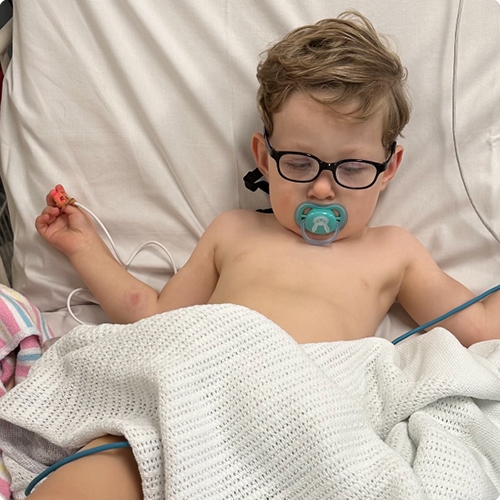Teddy, Age 2, Neurodevelopmental Disorder (CTNNB1 Syndrome)
Every parent knows the joy of their firstborn hitting milestones, like walking and talking– but for Lucy and Peter it is something they may never experience.

“I felt kind of overwhelmed at first. It took me a while to realise the gravity of it all. And then as he progressed in age, every milestone he missed really hit me in a different way.’’
At five months old, Teddy was diagnosed with CTNNB1 syndrome, a genetic condition that occurs randomly and is not usually inherited. It is a neurodevelopmental disorder similar to cerebral palsy that has physical, mental, and emotional challenges. His parents were told that Teddy may never walk or talk.
"I can recall three or four days later, looking into it a bit more myself,’’ Lucy said. “That's when I realised that this was a really big deal. And that's really when it hit me. And honestly, that was the only day I've cried about it. From then on, it's been ‘now what can we do to help him and make the most of his life?’”
Teddy is making slow progress, thanks to four days of therapy a week, but his parents still find it challenging to watch their baby daughter Audrey racing past Teddy as she crawls.
“You just love your kids, no matter what. We had all the genetic testing you can get while you're pregnant, and I didn't plan to have a child with a disability, but it happened, and you just move on.
“He's a joy, and I don't really know any different than taking my son to therapy every day. It's just reality for us.’’
A reality they weren’t quite prepared for was learning that there was research into Teddy’s condition happening right in their backyard in Australia.
At Children’s Medical Research Institute, Associate Professor Leszek Lisowski is doing research into the possibility of using gene therapy to treat Teddy’s condition. Gene therapy is the use of a healthy copies of genes “as medicine” – to treat or cure genetic disorders.
“It is a very emotionally demanding job,’’ Associate Professor Lisowski said. “When you meet families like Teddy’s we have this pressure of knowing the impact of our work. But I find it very rewarding to be doing something that matters and that one day may help someone.

Teddy with mum, Lucy, and Associate Professor Lisowski

“Genetic disease can destroy a child, parents, and a family and trying to change that is very motivating.’’
Teddy’s dad said he couldn’t believe the research wasn’t happening overseas; it was happening here.
“Meeting the researchers was incredible,’’ Peter said. “To meet someone so smart and knowing that our child's genetic disorder might be cured by this guy. It's like meeting a rocket scientist, but for genetics, it's incredible.’’
Lucy urged everyone to get behind them this Jeans for Genes Day.
“It can affect you out of nowhere like this. You might even know someone who has a condition that is being researched by the team at Children's Medical Research Institute, and they're so close to some incredible discoveries. We just need to tip it over the edge. And money is the way that more research happens.’’
Watch Teddy's Story

How research is helping kids with CTNNB1 syndrome, like Teddy
We are also spearheading new gene therapy initiatives to fill the gaps in Australian medicine. We want to ensure children facing genetic diseases go from diagnosis to cure, and that those cures are affordable and available right here at home.
Your support of Children’s Medical Research Institute by participating in Jeans for Genes makes all this and more possible.



